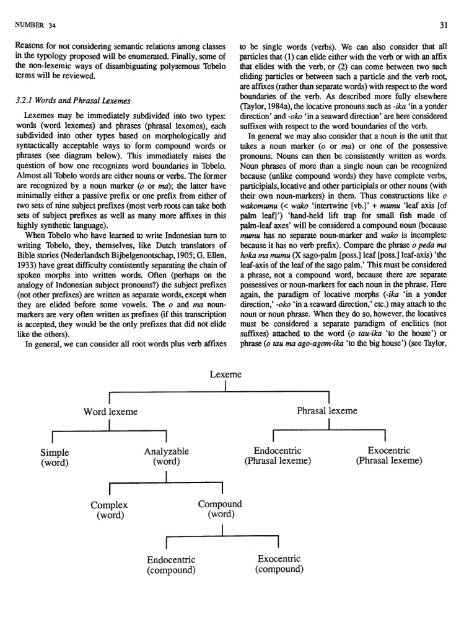The Folk Biology of the Tobelo People - Smithsonian Institution ...
The Folk Biology of the Tobelo People - Smithsonian Institution ...
The Folk Biology of the Tobelo People - Smithsonian Institution ...
Create successful ePaper yourself
Turn your PDF publications into a flip-book with our unique Google optimized e-Paper software.
NUMBER 34 31<br />
Reasons for not considering semantic relations among classes<br />
in die typology proposed wiU be enumerated. Finally, some <strong>of</strong><br />
die non-lexemic ways <strong>of</strong> disambiguating polysemous <strong>Tobelo</strong><br />
terms wiU be reviewed.<br />
3.2.1 Words and Phrasal Lexemes<br />
Lexemes may be immediately subdivided into two types:<br />
words (word lexemes) and phrases (phrasal lexemes), each<br />
subdivided into odier types based on morphologicaUy and<br />
syntactically acceptable ways to form compound words or<br />
phrases (see diagram below). This immediately raises die<br />
question <strong>of</strong> how one recognizes word boundaries in <strong>Tobelo</strong>.<br />
Almost all <strong>Tobelo</strong> words are eitiier nouns or verbs. <strong>The</strong> former<br />
are recognized by a noun marker (o or ma)', die latter have<br />
minimally eitiier a passive prefix or one prefix from eitiier <strong>of</strong><br />
two sets <strong>of</strong> nine subject prefixes (most verb roots can take both<br />
sets <strong>of</strong> subject prefixes as weU as many more affixes in this<br />
highly syn<strong>the</strong>tic language).<br />
When <strong>Tobelo</strong> who have learned to write Indonesian turn to<br />
writing <strong>Tobelo</strong>, tiiey, <strong>the</strong>mselves, like Dutch translators <strong>of</strong><br />
Bible stories (Nederlandsch Bijbelgenootschap, 1905; G. EUen,<br />
1933) have great difficulty consistendy separating die chain <strong>of</strong><br />
spoken morphs into written words. Often (perhaps on die<br />
analogy <strong>of</strong> Indonesian subject pronouns?) die subject prefixes<br />
(not o<strong>the</strong>r prefixes) are written as separate words, except when<br />
tiiey are elided before some vowels. <strong>The</strong> o and ma nounmarkers<br />
are very <strong>of</strong>ten written as prefixes (if this transcription<br />
is accepted, tiiey would be die only prefixes tiiat did not elide<br />
like die otiiers).<br />
In general, we can consider aU root words plus verb affixes<br />
Simple<br />
(word)<br />
Lexeme<br />
to be single words (verbs). We can also consider tiiat all<br />
particles that (1) can elide eitiier with <strong>the</strong> verb or witii an affix<br />
that elides witii <strong>the</strong> verb, or (2) can come between two such<br />
eliding particles or between such a particle and die verb root<br />
are affixes (ratiier than separate words) with respect to <strong>the</strong> word<br />
boundaries <strong>of</strong> <strong>the</strong> verb. As described more fuUy elsewhere<br />
(Taylor, 1984a), die locative pronouns such as -ika 'in a yonder<br />
direction' and -oko 'in a seaward direction' are here considered<br />
suffixes witii respect to <strong>the</strong> word boundaries <strong>of</strong> die verb.<br />
In general we may also consider tiiat a noun is <strong>the</strong> unit that<br />
takes a noun marker (o or ma) or one <strong>of</strong> <strong>the</strong> possessive<br />
pronouns. Nouns can <strong>the</strong>n be consistently written as words.<br />
Noun phrases <strong>of</strong> more tiian a single noun can be recognized<br />
because (unlike compound words) tiiey have complete verbs,<br />
participials, locative and otiier participials or o<strong>the</strong>r nouns (with<br />
<strong>the</strong>ir own noun-markers) in diem. Thus constructions like o<br />
wakomumu (< wako 'intertwine [vb.]' + mumu 'leaf axis [<strong>of</strong><br />
palm leaf]') 'hand-held lift trap for small fish made <strong>of</strong><br />
palm-leaf axes' will be considered a compound noun (because<br />
mumu has no separate noun-marker and wako is incomplete<br />
because it has no verb prefix). Compare die phrase o peda ma<br />
hoka ma mumu (X sago-palm [poss.] leaf [poss.] leaf-axis) 'die<br />
leaf-axis <strong>of</strong> die leaf <strong>of</strong> die sago palm.' This must be considered<br />
a phrase, not a compound word, because tiiere are separate<br />
possessives or noun-markers for each noun in <strong>the</strong> phrase. Here<br />
again, <strong>the</strong> paradigm <strong>of</strong> locative morphs (-ika 'in a yonder<br />
direction,' -oko 'in a seaward direction,' etc.) may attach to die<br />
noun or noun phrase. When tiiey do so, however, die locatives<br />
must be considered a separate paradigm <strong>of</strong> enclitics (not<br />
suffixes) attached to die word (o tau-ika 'to die house') or<br />
phrase (o tau ma ago-agom-ika 'to die big house') (see Taylor,<br />
Word lexeme Phrasal lexeme<br />
i<br />
Complex<br />
(word)<br />
Analyzable<br />
(word)<br />
Endocentric<br />
(compound)<br />
Compound<br />
(word)<br />
Endocentric<br />
(Phrasal lexeme)<br />
Exocentric<br />
(compound)<br />
Exocentric<br />
(Phrasal lexeme)

















